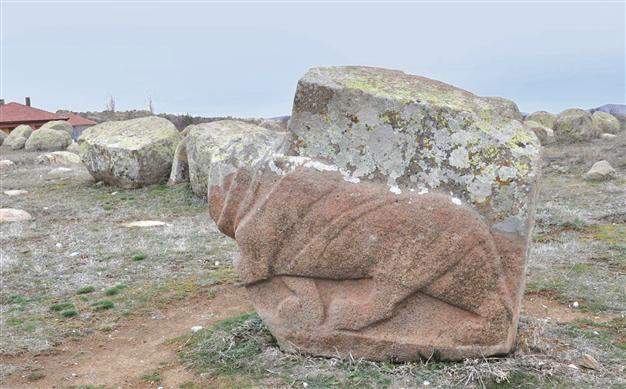Hittite sculptures to be displayed at open-air museum
YOZGAT - Anadolu Agency

An area of 1.5 kilometers in Yozgat’s Sorgun district that served as a sculpture atelier in the Hittite era will be reorganized as an open-air museum, thanks to a new project.
A site in the Central Anatolian province of Yozgat’s Sorgun district, which the ancient Hittites had used as a sculpture atelier, will be reorganized as an open-air museum by Turkey’s Culture and Tourism Ministry.
As part of the project, the Karakız, Kazankaya, Armutlu and Hapis Boğazı neighborhoods will be declared as first degree archaeological areas, according to local Mayor Osman Yılmaz.
The region was home to a large number of Hittite-era sculptures, some of which were unfinished, indicating that this may be why an atelier may have been located on the site, Yılmaz said.
“The first examination in this historical area was made in 1982 and it was taken under protection in 1987 as the Hapis Boğazı ruins. But no detailed work was conducted at the ruins until 2009, when the Yozgat Museum Directorate and Hittite University initiated joint works,” he added.
The mayor said there was a granite layer on a wide space in the region. “There are carved lion sculptures and pieces of various architectural structures in this area. We can see them over an area of 1.5 kilometers. We will preserve these artifacts in their original place and open them up to tourism,” Yılmaz said.
He added that the project, titled the “Open-Air History and Culture Park Museum,” would reorganize the area dating back to 1,200 B.C.
Following joint work with the Kayseri and Sivas Council of Monuments, the Culture and Tourism Ministry approved the project, Yılmaz said. “The most important feature of this settlement is that it is close to Hattusha, the capital of Hittite in the center of Anatolia. There are relief sculptures in front of the big gates in the entrances of significant cities in Hattusha and its vicinity. There is a sculpture atelier here. The Hittites used granite materials in making massive sculptures. This place has historical importance,” he added.
Sculptures will be moved Yılmaz said archaeological reports indicated that the area, where unfinished lion sculptures exist, served as an atelier in the Hittite era and many of the sculptures unearthed at Hittite settlements were made there.
As part of the project’s plans, the team made a change in the architectural plan of an area in the Karakız neighborhood and allocated it as an open-air museum.
“The sculptures in Kazankaya and Hapis Boğazı will be moved to a place in the Open Air History and Culture Park Museum. When the weather conditions is suitable, we will start moving the sculptures in spring, which is the first stage of the project,” Yılmaz said.
He also complained that treasure hunters had caused much damage to historical artifacts in previous year.
“Those who saw these sculptures made their own excavations in the region and damaged many of them. But with this latest project, these artifacts will be rescued from treasure hunters. This region is estimated to be the first sculpture atelier of the Hittites, and now it will be opened up to tourism,” Yılmaz said.
